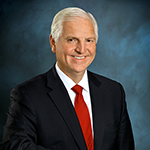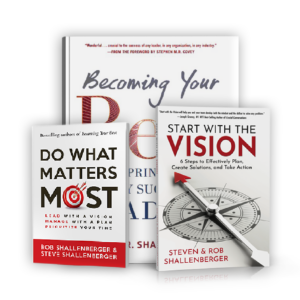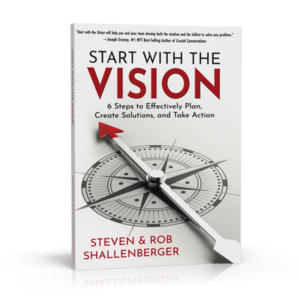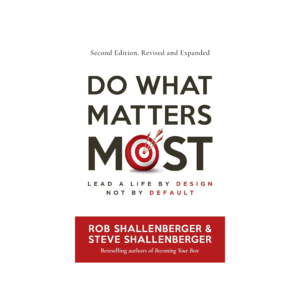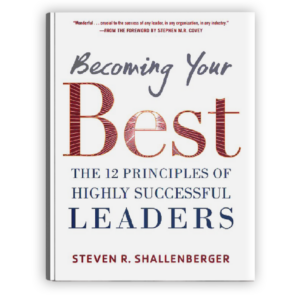
Episode Summary
In this episode, we are thrilled to welcome Marty Strong and hear about his unique perspective on leadership, planning, and goal achieving. Marty is a combat-decorated Navy SEAL, a thought-provoking writer and speaker, and a leader and business consultant. He is an accomplished novelist and the author of “Be Nimble: How the Creative Navy SEAL Mindset Wins on the Battlefield and in Business” and the soon-to-be-published “Be Visionary: Strategic Leadership in the Age of Optimization.”
Steve Shallenberger: Welcome to all of our Becoming Your Best podcast listeners. This is your host, Steve Shallenberger, and we welcome you with us today. We’re honored that you could join us, and always feel it is a privilege to be together with you. Today, we have—he’s going to feel a little embarrassed that I call him this—a hero with us, a special guest. He’s accomplished so much. He has been a leader for decades, first in uniform for twenty years as a combat-decorated Navy SEAL, and then in commercial business. He was a successful account vice president and portfolio manager with the United Bank of Switzerland for many years, then he became a marketing and business development senior vice president for a billion-dollar-a-year company. He later joined a small, early-stage growth company as an equity partner. Since then, he has developed several employee-owned startups as CEO and Chief Strategy Officer. Welcome, Marty Strong.
Marty Strong: Well, that was a lot. Thanks, Steve.
Steve Shallenberger: I’ve been looking forward to this, Marty. And our listeners may or may not know that every single week, we have probably 20 people that would like to be on this show. And when I learned about Marty, I said to myself, “Okay, this would be fun. We’ve got to have him and he has a unique perspective.” So, we’re so glad to have you with us.
Marty Strong: Thanks for having me.
Steve Shallenberger: Well, I’d like to tell you just a little bit more about Marty, then we’re going to jump right into our visit today. While there are many successful leadership books on the market written by former Special Ops professionals, Marty’s depth of experience in analyzing and leading businesses sets him apart from the crowd. It provides the reader with the appropriate and relevant commercial context to reflect on how Navy SEAL leadership concepts successfully convey outside of the military. So I’m looking forward to seeing that. He has a great background. One of the things I want you to tell us about, in addition to his undergraduate degree in business, and a graduate degree in Management, he is a Master’s Blackbelt in Lean Six Sigma. He is the author of nine novels and two business books, one to come out very soon, which we’re going to talk about today. But Marty, what is a Master’s Black Belt in Lean Six Sigma? I’m ready to defend myself.
Marty Strong: Oh, don’t. It was more about “know your adversaries better than themselves” kind of a thing. I’m more of a visionary dreamer concept kind of a guy, I always have been, that was probably my strong suit. Even in the SEAL teams, I was a good mission planner because I always saw it in three dimensions, I always saw the problem sets in that same manner. And yet when you get into business, there’s such a focus on measuring and microanalyzing all the results driven from past activities, which is fine. And when you’re starting out in business or you don’t have the credentials yet and you’re not at the CEO level like I am now, you can voice that maybe they’re spending too much time on this, but they look at you and go, “Okay, yeah, well, you don’t understand because you’ve only been in business for a year or two or three. You’ll get it someday.” So I thought rather than try to fight all the time, I’ll join them. So I enrolled in a Villanova Six Sigma course, which essentially, there’s green, black, and then Master Black Belt levels. In huge organizations like Raytheon’s and Microsoft’s of the world, the Master Black Belt would sit at the top, kind of like the Yoda, and be responsible for quality assurance, quality control, philosophy, procedures, and the dynamics, all the way through the organization reporting to a CEO. And then the army of black belts, usually, the leaders at the division level in big businesses. And then the green belts are like your foot soldiers running around and making sure all the quality assurance is done. But it’s about micro-measuring the Six Sigma is how many errors you haven’t 1 million executions, whether it’s making a widget or attempting to make a sale, it doesn’t really matter which.
Steve Shallenberger: That’s really great background in combination with a lot of the other things you’ve done. And when you apply good judgment vision to that, that works even better. Marty, tell us about your background, including any turning points in your life that’s had a significant impact on you.
Marty Strong: I’d say the first one was my father worked for the Department in the Army. He was a Navy sailor during the Korean War, which influenced both me and my brother eventually to join the Navy. But when I was 11 years old, he took a job in Japan. So the whole family moved from Omaha, Nebraska to Japan and we were there for four years. And not so much that you’re immersed in the Japanese environment, the economy, and society because when you can’t speak the language, it’s kind of tough. But it did get me out of the comfort zone of Nebraska, and it was a pretty significant impact on me, I think it’s stayed the same way for the rest of my life, where I can accept and understand other cultures. We did lots and lots of trips and saw a lot of things. I got to climb Mount Fuji when I was 14. And then my parents got a divorce. So, that was the negative side of that four-year experience. So I ended up back in Nebraska with my two siblings and my mom who had severe schizophrenia and also was a heavy drinker from the divorce. So we went through a bunch of turbulent times there. My mom kicked me out of the house, and by then my father lived in Honolulu, Hawaii. So I got on a plane and flew to go live with him for the next couple of years before I went into the Navy at the age of 17. So I ended up in four different high schools in four different years as a result. I ended up one of about 28 white kids or Hollies in a school that was predominantly Asian American in Honolulu, after four years in Japan. So all of those things were very traumatic and life-changing when you’re a teenager and you can imagine the angst of uprooting constantly. But I have to say, it’s probably what created the psychological resilience all in that allowed 125 pounds 17 year old to make it through SEAL training.
Steve Shallenberger: Wow, that’s quite a background.
Marty Strong: Yeah, and I’m only 17 at this point in the story.
Steve Shallenberger: Well, you’re right, you live or die in that kind of a situation and you grow up quick, don’t you?
Marty Strong: You do. And I was the oldest kid so I took on a lot of leadership responsibilities — old school relative to tell me, “You’re the man of the house now, you’ve got to be responsible.” And I took that to heart, tried to do the best I could, tried to shield my brother and sister from a lot of things. And I’d get jobs and I’d give them money and try to help them live a normal life as much as possible. But again, all those things, you know, good and the bad, you have to look at, it all ends up contributing to who you are. And luckily, both my brother and sister and I, all turned out really well. There are a lot of people that go left instead of right on that point of decision in life, whether you’re a victim and it’s happening to you and that’s just the way it’s going to be forever, or “Yeah, I’m a victim, but I’m not going to let it happen to me anymore and I’m going to go down a path where I take charge and control my world, my life, etc.” So, we went that direction. And again, I think it made all the difference eventually.
Steve Shallenberger: Well, that’s great. I’m glad you brought that up because life gives us the opportunity to grow, and it doesn’t do things to us the best things for us. That’s just what you seized upon, and that’s really great. Well, you wrote a book that’s coming out. You’ve written a number of books, but one that’s coming out in January entitled Be Visionary, do you mind just sharing with our listeners what the book is about and why did you write it?
Marty Strong: I wrote a book called “Be Nimble: How the Creative Navy SEAL Mindset Wins on the Battlefield and in Business” that was released in January of this year. And that was basically my treasure chest of ideas of how to lead through chaos and crisis. I’ve done a lot of scaling operations. It’s always exciting when you’re growing, but there’s a lot of stress, there’s a lot of anxiety, there’s a lot of emotion. There are a lot of people that get there. The reason they repeat a principle is that’s as good as they’re going to get. So sometimes you have to change out teammates, you’ve got to repurpose people. So I packed all that into the first book because that was primarily what people were coming to me and asking me to either mentor or coach or advise on. So I said, “Well, I’ll just write all this stuff down.” I’ve been doing this pro bono for a long time. And one of the chapters focused at some point on how to take the time to open your mind up and start to think in a visionary manner to look further and further away from today into the future, and also 360 degrees of coverage rather than just in a narrow lane. Then how do you convert that into an operational strategy, something that you can actually pursue and conduct in a business manner — doesn’t matter if you’re a for-profit or nonprofit, it can be a political entity, it all works. You know how it works; you write a book, and then by the time it’s going through the editing and everything, a lot of time goes by. So if you don’t start writing the second book, it’s going to be a while. So I started flushing it out and “Be Visionary: Strategic Leadership in the Age of Optimization” was the result of the response to that one chapter in the first book and the realization that I had, and I have a private equity-oriented board that I report to and there are bankers and finance people that have been in my past that you have to report to and brief. And you realize they focus a lot on what bankers and money people focus on, which is the micro accounting of past financial activities. And then there’s this assumption that that is going to give you a great navigational aid to the future. But in reality, what they really want to do is they want you to attack all the weak areas and shore them up and patch them up. And it’s less about what you’re going to look like and what you can do in the future or should do in the future, and more about, “This is what you have done, let’s fix this.” So it’s a very rearview-mirror approach to leading and managing. And I was also saying this at the same time I was finishing up Be Nimble. So, I’ve put those concepts and Be Visionary, both as a leader, how can you set yourself apart, set time aside to think different kinds of thoughts. Zoom out as much as you zoom in every day, and make that a habit, do it every day — I suggest 20 minutes a day, seven days a week because, eventually, when it’s a habit, you start looking at your checklist, your to-do list, your dashboards, your KPIs, and people reporting to you with that information, you go, “Yeah, but it’s not relevant because I’m thinking about what I think I see the trends that are coming.” And this seems like it’s important to you, gotta check it, you measured it, but it’s not taking us where we need to go because your mind has been thinking that way because you’ve started exercising that part of your brain. So, that’s the first lead into the book and the second part is how do you convert that into an actionable strategy?
Steve Shallenberger: Thanks for that overview. Marty, from your experience, you just touched on this a bit, how can we learn to improve our visionary skills in a way that can be applied both personally and professionally?
Marty Strong: Well, everything I just said about the vision piece, absolutely, should be applied to your personal, professional, and organizational future. So if you are a leader or the leader of an organization, then, by all means, you should be applying that. And the personal, I look at it, you’ve probably run into this, in privately-owned companies, I’ll sit down and they want to talk to me about the strategy and I go, “Fine. So, you’re the owner, right?” “Yeah, I’m the 100% owner.” “So, what’s your exit plan?” And they stare at me, “Well, what do you mean ‘an exit plan’?” “Well, what do you want out of this for yourself? You started this company four years ago, six years ago, and you’re working 80-90 hours a week. What’s the endgame? Where do you want it to go?” And you’re probably not surprised, but most people probably would be surprised that probably 80% of those business owners haven’t given a thought to it. They started the business, they started grinding on day one, 10 years later, they’re still grinding. One response was very eloquent and very highly detailed briefing back to me of the entire business development plan. And then when the person was done, I said, “That’s a great operational plan for how to grow your business from where it is now, but what’s your strategy? Where do you want the business to go? Where do you want to be at the end of this, personally?” So I think it’s a gap in individuals, whether they’re family members, fathers, or mothers, looking at what it is they want to do, personal growth. And that exercise will give you some ideas what you can be or might be, and then you can use that same second step, which is how do you back plan from that point in the future? Whether it’s an easy segue to something like losing weight because there’s a metric. But what if you just want to able to run a marathon? Just want to finish a marathon, you don’t care what the time is. So, that’s the goal, and you want to do it 24 months from now. You want to be in the New York City Marathon or the Marine Corps Marathon in Washington, DC. So, you back plan: how many miles do I have to put in? What do I have to do as far as my health? And it gives you a purpose to back plan and hit these milestones, which you can do in a baby step, one-step approach at a time. That’s for you as a person. You can apply the same thing professionally, where do you want to be in your industry or your market within your own corporation or company if you’re not in charge? Or if you are in charge and you’re the CEO, like I’m in my 13th year, is this what you want to do forever in perpetuity? Or is there something else you’d really be happier doing? And how are you going to segue out with the least amount of disruption? And lastly, I think we’ve already hit on, how do you take your organization into the future.
Steve Shallenberger: Marty and I were visiting about “Becoming Your Best: The 12 Principles of Highly Successful Leaders” just before we started. We were just talking about how universal these principles are, but not everybody is aware of them nor do they practice them. But I know Marty would chuckle a bit because the first one of the 12 is “be true to character,” it’s all about honesty, integrity, and respect. And if you don’t have that one, leaders, you’re going to have a big problem. But number two, and this is to really give support to his book, Be Visionary, is “highly successful leaders lead with a vision.” That’s the second one we identified. And that’s job number one, whether it’s personally or professionally. And number three principle is “manage with a plan.” And Marty just covered all those right there in a few minutes. I love his unique perspective of how he’ll talk about these principles. And I think that’s why I’m excited to read your book. I’m going to gain new insights that I haven’t had about how to be better at doing that. Let’s shift gears a little bit, and lessons derived from you being a Navy SEAL. What are some things that you learned from being a Navy SEAL of how you can apply leadership lessons in other areas of your life, particularly, in the visionary or strategic area?
Marty Strong: SEALs operate more in the operational and tactical world. They’re a small unit, they’re an elite unit, so they don’t get involved in big Navy strategy or national strategy. But what they are is they are the instrument of national strategy. So, oddly enough, usually, when special operations forces are applied, it’s for national strategic interest. So it’s always been important, I think, to me and other leaders in the SEAL teams to stay on top of what the national strategy is, what the trends are, what the strategic threats are because it gives us the precursor signposts or blueprints to where we’re probably going to be employed next — so that’s the environmental geography kind of thing. The geopolitical reality is where might be employed next. The missions themselves may not change much, but where the leadership at the operational level conveys and also could supplement—and I’ve used this in other examples for business strategy development—is the flexibility that special operations leaders are taught and other operating enlisted guys, everybody’s taught the same way, when whatever your assumptions are for your mission have completely fallen apart. The movies, for the most part, always show the crisis on the target when somebody gets shot or the helicopter doesn’t show up. But what really happens is you start off with a whole lot of assumptions you’re fed, just like business people are, this is the lay of the land, this is the risk you’re going up against, this is the number of bad guys, this is what they’re going to be armed with, this is the distances required, and this is the weather. And then you make a plan, and then they make you rehearse it, and they make you brief it until you’ve memorized the plan. And anybody that’s ever been in the Special Operations world in any of the services knows, at this point, they’re all rolling their eyes because that plan is never going to happen. It’s just not going to happen. There are jsut too many micro assumptions building up this base foundation of assumption. So, it’s kind of a house of cards. So, what happens is a lot of the failure in the plan happens before you ever get to the target, whereas in movies, they show all the failures to the plan are happening on the target. And the reason that’s key to this conversation is to train leaders to have a nimble and agile mindset to be ready to roll with the reality of the assumptions changing before they ever get to the target, which means that they’re in a constant state of being open-minded and intellectually humble to what’s happening in the reality in front of them. And when that reality changes, they don’t sit back and close their eyes and say, “I hope it goes back to the way we planned it. I hope that the weather doesn’t do it as it looks like it’s going to do. I hope we get the helicopter we asked for, we don’t have to go in by submarine.” You don’t do that. You immediately say, “Okay, this is reality.” Everybody’s looking at you and you go, “Okay, what are the new set of circumstances?” You lay them out, you adjust the plan, and you move with the new reality until that reality changes. What that does, and you can train a management team to do this.
Marty Strong: All they do in the SEAL teams is they do it through scenario-based training. You’re in a constant state of being fed a situation and then they inject changes to the assumptions, and the team has to reroute, rethink, reimagine, and reinvent. There is a lot of detailed plan to this: How many fuel hours? What kind of aircraft? How many aircraft? How about refueling those aircraft? All of that is swinging around by the tail of that dog when they change assumptions. So, there will be hundreds and hundreds of other people that are supporting you, they have to change their plans, too. And you get very comfortable with that being the normal way things are going to be. In business, you hardly ever see any organizations do this. So they don’t have the resilience, then when the assumptions change, when things adjust. They also don’t have the flexibility to see a need for change and strategy for what it really is because they’re in denial. In any kind of Black Swan event like the pandemic, you basically do the three different behavioral responses you had, “I’m going to knuckle down and believe this is just going to go away. I’ll double down on the past and what we do.” You have a hybrid of doing the denial for a short period of time and grudgingly “Okay, I guess we’re going to have to reinvent who we are.” And then you have that third group, the rare group, that immediately says, “Everything’s changed. Get everybody in the room. We’ve got to figure out what we’re going to look like starting today.” Basically, that’s how that transitions from the SEAL, the experience that SEALs trained to, and the boardroom or management organizations.
Steve Shallenberger: I love all the parallels, and that gets back a lot to your book of being nimble, too.
Marty Strong: It’s all human nature. Everybody has the same human brain. We all function, fear, failure, fight or flight, it’s all the same thing, you have to just train to it and prepare for it and create habits that put you in an advantageous position when it happens because it’s going to happen.
Steve Shallenberger: The most successful teams or organizations that I’ve seen do exactly what you talked about; they have a plan, but they’re also anticipating all of the things that can go on, and ready to jump if things go south in one area. And they also help create a culture that’s like that, that we’re learners, we adapt, and we have one thing in focus that we want to be among the very best at what we do. And then from there, everything else, you put your plan in place, and sometimes things go south. So I love what you’re talking about. Thank you for sharing this insight. What have you done, Marty, in an organization when you have people that are resistant to change?
Marty Strong: You mean every single solitary human organization on the planet? Well, you talked about culture. Let’s say, an enlightened CEO who believes in all these things, they’ve read your book and they’re following your 12 principles, and they’ve read my book and they’re reading all these books, and then they turn around and they’ve got 1,000 or 80,000 people reporting to them. They’re not going to get anywhere unless they take the next step and turn that into a cultural requirement at the next level of management or the next level of management below that. And then they have to follow up and check and make sure that it’s actually embedded and it’s happening. You’ve got to go all the way to how we’re hiring people. So if you hire people to go into a culture, if the culture is all about fitness or the culture is all about fashion or it’s all about high quality, you can’t bring in people that aren’t that way, they don’t think that way, they don’t care about those things. I don’t care if it’s an accountant, find an account that has a fashion sense. Have somebody that’s compatible with the culture that you’ve either created or that you’re trying to create. So, it’s the same thing with these things. I’ll use the accountant thing again. Don’t just hire the accountant because the accountant’s resume checks all the boxes, you need an accountant that can come in and be comfortable working with other people, including non-accountants. Being thrown into a project team to try to solve some strange problems because they happen to manage spreadsheets, not because we need them to follow the GAAP rules of accounting.
Marty Strong: Look for a sense of humor — sense of humor is a huge part of all special operations personalities. It can be the nervous sense of humor. There’s an old rule in SEAL training, the selection course: When things are going really bad, look around, and the people that are laughing and joking about it, get close to them. It’s contagious. And that’s the right way to react to stress is to laugh it off and come up with a new plan. The people you see that are moping and getting all worried and talking about how bad it is, stay as far as you can from them. Well, it’s the same thing when you’re hiring. So you can be struggling to create cultural organization, but if you haven’t started the input side, you’re going to be losing the whole time. So, yeah, you have to push it all the way down. I spent a lot of time and I’ve been in organizations where that was established and then we changed out our Human Resources senior person. We forgot to go down and have them drink the Kool-Aid, and all of a sudden, a year later, we’re getting some weird reports that people are rolling out at 04:30 and we’re in a big crisis pricing exercise, and people are leaving like it’s a day job, which wasn’t part of the culture. We had a culture that was “work hard, play hard.” So if we were in a surge, everybody would work. We had lodging set aside and people could stay and everything, but then we’d give them the whole next week off. We were very good about that. But then there were groups who came in and said, “Thanks for the week off, but I’m leaving at four o’clock during the surge period.” And when we investigated it, the root cause was the change in the HR management. And the real root cause was we didn’t make sure that our cultural philosophy had been imparted to this new person that was at this critical gatekeeper position. So, it really was all on us, we did it to ourselves.
Steve Shallenberger: Great stuff. I’d love to just visit another hour or so with Marty today. I’m always a little bit surprised at how fast these interviews go, and we’re at the end. So, before we end, do you have any final tips that you could share with our listeners today whether on a personal or professional level that would help them in their leadership and overall success in life?
Marty Strong: On the personal side, I spent a lot of time working with transitioning veterans, they face the same life choices, somebody coming out of high school looking at the big wide world or somebody graduated from college looking back in hindsight now. I think the pressure always has been, whether it’s society or parents putting this pressure on people with this expectation that you’re supposed to become a homerun hit right out of the box. So, that’s one thing. The second thing is that there’s no such thing as a second chance at coming out of the box. Especially, in this country, you have the ability to become an accountant, work for four years, decide you want to be a saucier, go to chef school at night, work in a restaurant for 10 years, decide you want to write a magazine, become a magazine owner, publisher, writer, whatever, do that for x number of years, go take painting classes and decide to do greeting card artwork or something. You can do any of those things, all of those things, you can do them in parallel. And I’m just stunned, it doesn’t matter what the age is, the conversation with an 18-year-old, a 23-year-old, and a 40-year-old coming out of uniform is the same anxiety that “I have to make the perfect choice. And that perfect choice has got to be something that lasts for the rest of my life.” That’s way too much pressure. So think and train about the thing that you’re interested and passionate about, why you still have the day job, why you’re still in your last couple of years in high school, why you’re still in college. Prepare for that, go do it, apprentice yourself out, learn from the ground up. You’ll either like it, love it, or you’ll leave it right. And then do it all over again, on the professional side, that 20-minute-a-day thing, it just sticks with me. I noticed when I get sucked into problem-solving for a couple of weeks, that I’ll look up and realize I haven’t been doing that same practice. And I get this weird feeling in the back of my head like there’s a train coming and I can’t see it coming because I haven’t been looking. So I think that’s probably the strongest thing for professionals, whether they’re individuals or people running organizations: put in that 20 minutes to think big thoughts.
Steve Shallenberger: Do you have a structure to that, Marty, when you do that?
Marty Strong: I don’t. The first thing I do, though, I practice intellectual humility; I try to clear my mind of all my recent victories or defeats so, emotionally, I’m open to being curious. So intellectual curiosity is the second step. Now, I’m open to think about anything and consider all inputs from all sources in all directions. And then what that sets me up for at the end of that 20 minutes is the third step, which is more of the daytime application of it, which is intellectual creativity, I don’t think you can get to honest intellectual creativity, changing the world, changing your world, or your organization’s future unless you’re completely clean and cleansed of the baggage and if you haven’t actually allowed yourself to look everywhere, 360 degrees, for solutions and answers. Because otherwise what you’re doing is you think you’re being creative, you’re just basically reinventing the wheel, you’re pushing the same formula, same football play forward, you’re not really being creative. So, that’s how I did the first two, intellectual humility and curiosity happen in that 20 minutes, range widened far when you’re in that mode. And that sets you up to start being much, much more intellectually creative down the road.
Steve Shallenberger: That’s great. And when do you find is the best time to do that?
Marty Strong: I do it in the morning. I’m an early riser, so I do it sometime around 05:30 every morning. On weekends, I might do it in the afternoon. For some reason, it seems like on Saturdays and Sundays, it’s kind of a moment. My wife likes to take naps around two o’clock and I’ll find myself in between tasks, but you have to make it a habit. And it’s like working out or something; you know if you’ve been doing that and then you don’t do it for a couple of days, you get that weird feeling in the back of your mind like there’s something important missing from your life. It’s the same way if you establish this as a practice.
Steve Shallenberger: And you love doing it, don’t you?
Marty Strong: Yeah. I’ve had some insights that have been significant, and I’m glad I stumbled on it and I’m glad I keep practicing that habit.
Steve Shallenberger: That’s great. So, Marty, how can people find out about what you’re doing?
Marty Strong: The cleanest way, probably, is to go to my website: MartyStrongBeNimble.com. Access to all my books, my novels, and my business books are there and my articles. I’m also on Amazon.com.
Steve Shallenberger: Well, it has been a delight to have Marty Strong with us today. Once again, thanks for your service to our country and for all of the really cool things that you’re doing today and blessing so many people. So, thanks for being with us, Marty.
Marty Strong: Thanks for making this a possibility for me. I enjoyed it, Steve.
Steve Shallenberger: Me too. And to all of our listeners, we’re so grateful for you. You are an inspiration to us. Literally, the fact that you’re here, that you’re listening, that you’re looking for ways to do better and be happier and stronger and more effective in the things that you do. And this is a blessing to all of the people in your life. So thanks for joining us. This is Steve Shallenberger, wishing you the best today and always.

